

The Lifespan of a Lie – Trust Issues. It was late in the evening of August 16th, 1971, and twenty-two-year-old Douglas Korpi, a slim, short-statured Berkeley graduate with a mop of pale, shaggy hair, was locked in a dark closet in the basement of the Stanford psychology department, naked beneath a thin white smock bearing the number 8612, screaming his head off.
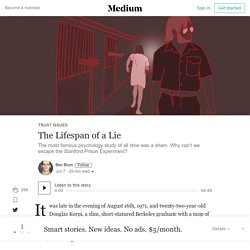
“I mean, Jesus Christ, I’m burning up inside!” The Brain That Couldn’t Remember. Wilhelm Wundt: Psychology OnLine.Net. Wilhelm Wundt is the first man who can be called a psychologist without qualifying the statement by reference to another stronger interest.
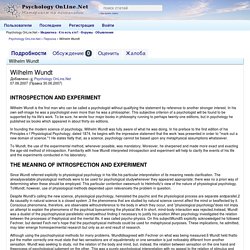
In his own self-image he was a psychologist even more than he was a philosopher. This subjective criterion of a psychologist will be found to be supported by his life's work. To be sure, he wrote four major books in philosophy running to perhaps twenty-one editions, but in psychology he published six books which appeared in about thirty-six editions. In founding the modern science of psychology, Wilhelm Wundt was fully aware of what he was doing. Project Gutenberg Self-Publishing - eBooks. STERILIZED in the Name of Public Health. Experiment shows magnetic chips could dramatically increase computing's energy efficiency. In a breakthrough for energy-efficient computing, engineers at the University of California, Berkeley, have shown for the first time that magnetic chips can operate with the lowest fundamental level of energy dissipation possible under the laws of thermodynamics.

The findings, to be published Friday, March 11, 2016 in the peer-reviewed journal Science Advances, mean that dramatic reductions in power consumption are possible—as much as one-millionth the amount of energy per operation used by transistors in modern computers. This is critical for mobile devices, which demand powerful processors that can run for a day or more on small, lightweight batteries. On a larger, industrial scale, as computing increasingly moves into 'the cloud,' the electricity demands of the giant cloud data centers are multiplying, collectively taking an increasing share of the country's—and world's—electrical grid.
Magnetic computing. A Book About Neuroscience’s Most Famous Patient Sparks Controversy. At the age of seven, Henry Gustav Molaison was involved in an accident that left him with severe epilepsy.
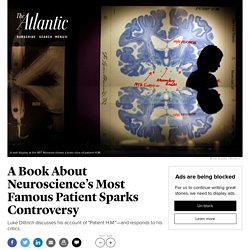
Twenty years later, a surgeon named William Scoville tried to cure him by removing parts of his brain. Stanley Milgram Obedience Experiment (May,1962) Helen Bradford Thompson Woolley. By Samantha Ragsdale Helen Bradford Thompson Woolley was a psychologist, a social reformer, a women's rights leader, a mother of two daughters and takes claim for many significant "firsts" in psychology.

She was born in Chicago, Illinois to David Wallace Thompson and Isabella Perkins (Faxon) Thompson on November 6, 1874. Her father was a shoe manufacturer and her mother a homemaker. She is sometimes referred to as and referenced as Helen Bradford Thompson, as her major work was published before her marriage.
Both her mother and her father were advocates of education for women and were very supportive of her academic interests. At the University of Chicago, she carried out the first major research concerned with the differences between men and women. Sofia University » Transpersonal Pioneers: Mary Calkins. Mary Whiton Calkins Mary Calkins was among the first generation of women to enter psychology.

Jessica Lahey’s ‘The Gift of Failure’: A Fear of Risk-Taking Has Destroyed Kids’ Love of Learning. I’ve known the mother sitting in front of me at this parent-teacher conference for years, and we have been through a lot together.
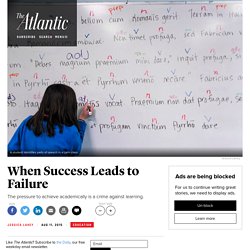
I have taught three of her children, and I like to think we’ve even become friends during our time together. She’s a conscientious mother who obviously loves her children with all of her heart. The Dangers of Using a Sticker Chart to Teach Kids Good Behavior. After working with thousands of families over my years as a family psychologist, I’ve found that one of the most common predicaments parents face is how to get kids to do what they’re asked.

And one of the most common questions parents ask is about tools they can use to help them achieve this goal. One such tool is the sticker chart, a type of behavior-modification system in which children receive stickers in exchange for desired behaviors like brushing their teeth, cleaning their room, or doing their homework. Kids can later “spend” their accrued stickers on prizes, outings, and treats.
Though data on how widely sticker charts are used (and when and why they became so popular) is difficult to find, anecdotal evidence suggests that these charts have become fairly commonplace in American parenting. Lashley1950. Introduction to Binet (1905/1916) by H.L. Minton. An internet resource developed byChristopher D.
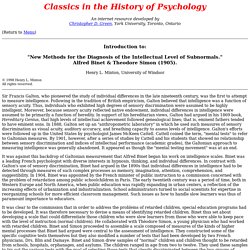
Green, York University, Toronto, Ontario. Birds conform to local 'traditions' The Power of Nazi Propaganda. Huffingtonpost. Divided attention test. History. Marie Jean Pierre Flourens (1794–1867): an extraordinary scientist of his time. Psychclassics.yorku.ca/Skinner Conditioning. List of experiments. The Magical Number Seven. Home | Site Map | Watch | FAQ | History | Store | Contact originally published in The Psychological Review, 1956, vol. 63, pp. 81-97 (reproduced here, with the author's permission, by Stephen Malinowski) Belorussian translation German translation Table of Contents.
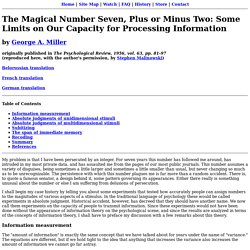
8pcs Minifigure Lot Building Blocks Series Toy WWE World Wrestling Entertainment. Controversy in Ethics of Obedience Research. Controversy: Ethics in ExperimentsPsychological Harm and Informed Consent This experiment led the American Psychological Association to carefully review its human subject procedures. 'Pawn Star' Rick Harrison On His 'Deals And Steals' Rick Harrison and his family run a 24-hour pawn shop in Las Vegas.
Erik Kabik/erikkabik.com/History Channel hide caption itoggle caption Erik Kabik/erikkabik.com/History Channel Rick Harrison and his family run a 24-hour pawn shop in Las Vegas. Mystery solved: We now know what happened to Little Albert. One of psychology's greatest mysteries appears to have been solved. “Little Albert,” the baby behind John Watson's famous 1920 emotional conditioning experiment at Johns Hopkins University, has been identified as Douglas Merritte, the son of a wetnurse named Arvilla Merritte who lived and worked at a campus hospital at the time of the experiment — receiving $1 for her baby's participation. In the study, Watson and graduate student Rosalie Rayner exposed the 9-month-old tot, whom they dubbed “Albert B,” to a white rat and other furry objects, which the baby enjoyed playing with.
Later, as Albert played with the white rat, Watson would make a loud sound behind the baby's head. Why Watson's Little Albert Became the Most Distorted Study in the History of Psychology. Mystery solved: We now know what happened to Little Albert. Jane Elliott's Blue Eyes/Brown Eyes Exercise. First Blood Test to Diagnose Depression in Adults: Northwestern University News. CHICAGO --- The first blood test to diagnose major depression in adults has been developed by Northwestern Medicine® scientists, a breakthrough approach that provides the first objective, scientific diagnosis for depression.
The test identifies depression by measuring the levels of nine RNA blood markers. RNA molecules are the messengers that interpret the DNA genetic code and carry out its instructions. The blood test also predicts who will benefit from cognitive behavioral therapy based on the behavior of some of the markers. This will provide the opportunity for more effective, individualized therapy for people with depression. In addition, the test showed the biological effects of cognitive behavioral therapy, the first measurable, blood-based evidence of the therapy’s success.
Redei is co-lead author of the study, which was published Sept. 16 in Translational Psychiatry. Redei previously developed a blood test that diagnosed depression in adolescents. How the Study Worked. Weber Fechner Laws. Hippocampal place cells recorded in the Wilson lab at MIT. From Clever Hans to the modern day - The Berkeley Science Review. Clever Hans couldn’t do math, but he was really good at reading human body language.
Photo via Wikimedia commons. In the early 1900s, scientific and public attention to animal cognition and intelligence was focused on the performance of one animal, Clever Hans the horse. A Science Odyssey: People and Discoveries: Ivan Pavlov. The Secrets Behind Psychology’s Most Famous Experiment. 10 Famous Psychological Experiments That Could Never Happen Today. Here are the stories behind the nicknames of the NFL’s 32 teams—and what they were almost called. All photos via Getty Images. Getty Images The franchise began play in Chicago in 1898 before moving to St. 25 Mind Blowing Psychology Experiments...You Won't Believe What's Inside Your Head.